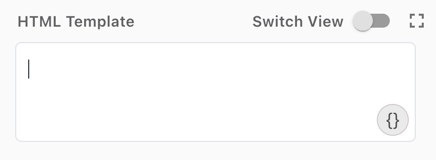Including variables and other data
Many of the nodes in a flow can make use of data from outside of the node. This data can include:
-
Global variables: Parameters available throughout the flow. These parameters can come from the flow invocation, the environment, or other sources.
-
Node-specific data: Many nodes create or import data, such as user details, which is then available to future nodes.
-
Variable values: You can include variable values from relevant variable types.
To include one or more of these parameters in a node:
-
Create or open a flow.
-
In your flow, select a node, then locate a field that requires data.
-
In the field, click the {} icon.

-
In the Choose Connection list, select Global to add a global variable, select a previous node name to add data from that node, or select a variable type to add a variable value.
The selected category expands to display specific
By default, you can only select nodes that precede the current node. If the flow contains loops, you can click Show All Nodes to display nodes that appear later in the flow.
-
Select a value to include.
-
Click Apply after you finish adding parameters.
Global variable reference
Global parameters are parameters available throughout the flow.
| Parameter | Description |
|---|---|
|
The company ID for the environment. |
|
The ID of the flow. |
|
The flow version number being run. |
|
The ID for the flow execution. |
|
The ID of the flow policy used to launch the flow. |
|
The end user’s IP address. This value is repopulated by the most recent HTTP request. This can include out-of-band continue or webhook nodes that are active on the current branch of the flow, where the client might be different from the one that initiated the flow. |
|
The end user’s user agent. This value is repopulated by the most recent HTTP request. This can include out-of-band continue or webhook nodes that are active on the current branch of the flow, where the client might be different from the one that initiated the flow. |
|
An object containing authorization request parameters. |
|
The cookies present in the API request that invoked the flow. |
|
The value of the Origin header. |
|
A string used to address the case where the UI the user is interacting with has a different domain than the domain the widget is making API calls to. |
|
A header used by the Chrome Enterprise connector. |
|
A header used by the Chrome Enterprise connector. |
|
The timestamp at which the most recent node in the flow was executed. For example, |
|
The timestamp at which the most recent node in the flow was executed in human-readable format. For example, |
|
The value of the session token cookie that PingOne uses to track the authentication session. |
|
A value that controls the expiration of the PingOne session token cookie. |
|
The PingOne User ID for the current user, if it is known. |
|
A boolean indicating whether the flow was launched with the SDK. |
|
A string value indicating which platform invoked the SDK request. |
|
The socket IP address of the connection used to submit the most recent request. |
|
Indicates whether the connection used to submit the most recent request has been verified. This value is currently always set to false. This value is currently always set to |
|
The SHA-256 thumbprint, in lowercase hexadecimal, of the mTLS certificate used by the connection that submitted the most recent request. For standard TLS connections, this value is empty. This variable is used when mTLS is enabled for the custom domain. Learn more in the API reference documentation. |
|
The custom headers submitted with the most recent request. |
|
The user’s language setting. This value comes from the user’s browser language setting unless overridden by the Variables connector. |
|
An object containing the parameters of the request made to invoke the flow, if the flow has an input schema. |
|
An object containing information about the user if the user has been identified. |
|
A string containing the custom domain, if one is being used to access DaVinci. |
|
An object containing the userId and authentication methods fulfilled by a PingOne capability, if any. |